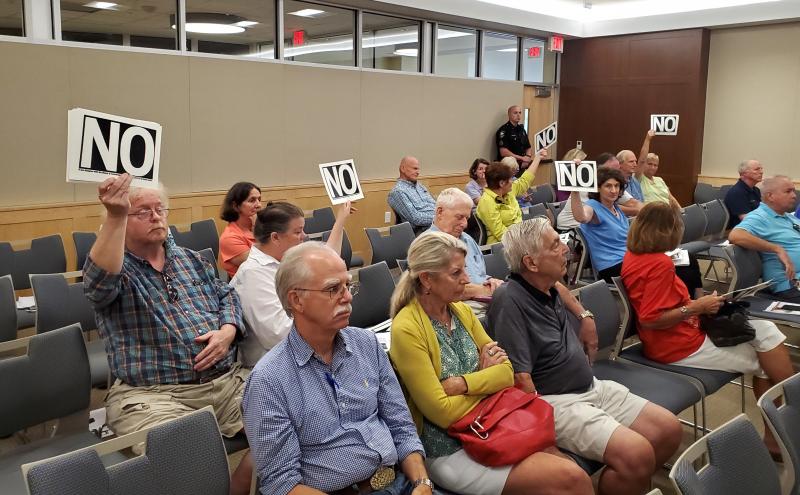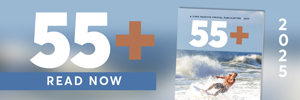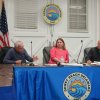Flat-rate utilities coming to Rehoboth Beach
After months of discussion, Rehoboth commissioners have instituted a 3 percent lodging tax and changed the method of billing for wastewater and water utilities. Both votes were taken during the Aug. 16 commissioner meeting.
Commissioners tackled the change in the utility rate billing structure first, which passed by a 5-2 margin. Mayor Paul Kuhns and Commissioners Richard Byrne, Pat Coluzzi, Steve Scheffer and Lisa Schlosser voted in favor of changing the peak/nonpeak method of billing to a flat-rate structure. According to the new ordinance, the flat-rate utility billing will become effective for bills processed on or after Nov. 1.
Commissioners Stan Mills and Toni Sharp voted against the change.
The passage of the flat-rate system came after a healthy dose of public criticism.
Resident Suzanne Goode said other coastal towns with a big discrepancy in summer and winter populations don’t have flat-rate systems, and she questioned why Rehoboth was instituting such a business-friendly system.
Resident Edie Herron asked why commissioners had just accepted the proposal from the working group and not re-evaluated it after an overwhelming reaction to keep the peak/nonpeak system during a town hall meeting. She said she understood the need for significant rate increases, but she said the percentage for larger users wasn’t going to go up proportionally as much as it was for smaller users.
Kuhns responded by saying in the past, under the peak/nonpeak billing, the higher users were subsidizing the lower users.
Resident Donna Mabry said there’s no valid reason for the change. The seasonal users are more costly to service, she said, and the only way to capture their usage is by charging more during the peak season.
Public Works Director Kevin Williams said that wasn’t the case. He said most of the costs to the water and wastewater system are in the system itself, and the increase of people during the peak season really just means an extra pump and a larger pipe for flow. If the flow triples in July, it doesn’t triple the costs, he said.
Coluzzi said she is confident ratepayers are going to be better off, with a more accurate bill.
Byrne said there was no agenda to benefit any specific payer, and he thought this was going to be better for the community as a whole.
Scheffer said no system was going to be perfect, but this is reasonable.
Schlosser said the new billing doesn’t benefit one group over another, and going with a system that’s 20 years old may not be in the best interest of the community as a whole.
Sharp said there’s been an overwhelmingly negative reaction at meetings and wanted to know what the business community was thinking.
Coluzzi said if the business community was against the change, they’ve had many meetings to voice it.
Mills said he wanted more time for communication. “I don’t believe we’ve done enough communication. Close, but not enough,” said Mills.
The change to the utility rate structure was first proposed by a working group in June, after nearly six months of work. The group evaluated infrastructure needs for the two utilities over the next 12 years. According to an executive summary prepared by the group, the water fund shows a projected shortfall of $20 million based on estimated requirements for the water system; the wastewater system shows a projected $25 million shortfall.
As adopted, for every 1,000 gallons used, the city would charge $14.70 for wastewater and $6.30 for water for the first four years of the 12-year cycle. The rates will be readjusted every four years.
To begin paying debt and making improvements, the city approved an interim rate increase in April – water increased 30 percent; wastewater increased 60 percent.
Under the approved rates, the water rate will be closer to a 40 percent increase, while the wastewater rate will be closer to a 70 percent or 75 percent increase.
In the past, Williams has said the 30 percent and 60 percent increases would have covered costs only for the current fiscal year. He said rather than change the rates every year, the group proposed a four-year cycle where rates cost more than needed in the beginning, but less than needed in the end.
In addition to paying for needed infrastructure improvements, the change incorporates a total of $800,000 in reserves for water and wastewater, and removes a wastewater contribution to the city’s general fund. Going forward, under the proposed plan, that contribution would be captured in the water rate.
Three percent lodging tax
The creation of a 3 percent lodging tax has been in the hopper even longer than the change to utility rates.
In September, city commissioners voted unanimously in favor of a charter change allowing the city to impose a tax on hotels, motels and tourist home rentals. A bill finalizing the change was signed into law in June.
There was much less public comment on the lodging tax, but one hotel owner, Richard Kirchhoff, of Canalside Inn, did speak against the new tax. He said the hotel owners are not being treated fairly, because it’s asking 18 to 20 business owners to pay a tax that only reaches a small portion of the tourists using city amenities.
If the goal is to tax the tourists, it needs to be a whole lot broader, said Kirchoff. Hotel guests are aware of the 8 percent already charged; making it 11 percent is moving up to big-city rates, he said.
The tax will take effect Jan. 1, 2020. This new tax would not affect people who rent houses in Rehoboth, who already pay an accommodations tax of 6 percent, all of which goes to the city. House renters do not pay the state tax.
Chris Flood has been working for the Cape Gazette since early 2014. He currently covers Rehoboth Beach and Henlopen Acres, but has also covered Dewey Beach and the state government. He covers environmental stories, business stories and random stories on subjects he finds interesting, and he also writes a column called Choppin’ Wood that runs every other week. He’s a graduate of the University of Maine and the Landing School of Boat Building & Design.






















































